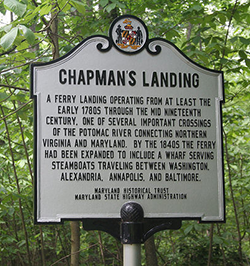History of Chapman State Park

Indigenous People and European Contact
Archaeological evidence indicates people began inhabiting the area which now includes Chapman State Park approximately 3,000 years ago. By about 1300 A.D., Algonquin-speaking peoples lived from the Chesapeake Bay to the foot of the Appalachian Mountains, encompassing modern-day Southern Maryland and Northern Virginia. Most lived in semi-permanent villages or towns featuring “long-houses” surrounded by wood palisades. These Indigenous People were deeply connected to the land that they revered. For sustenance they grew corn, beans, and squash near the villages, as well as fished, hunted game and gathered fruits, nuts and berries.
During his exploration of the Potomac River in 1608, Captain John Smith identified the people living near present-day Chapman State Park as the “Pamacacack.” Later called the Pamunkey, the people were closely aligned with the Piscataway, who dominated most of Southern Maryland until the arrival of European settlers in the 1630s. It is unclear if this Pamunkey tribe is related to the Pamunkey tribe of Virginia. As English colonists moved into the area, some of these people adopted a few of the colonists’ customs, such as hog farming. Over time, however, disease and other factors caused the native population to decline or flee to other areas. Some Pamunkey continued to live in the immediate area until about 1720, while various other Piscataway bands have remained important contributors to Southern Maryland history and culture to the present day.
Tobacco Plantation, Ferry and Fishery
By the 1730s, English settlers had moved to the area of present day Chapman State Park, cleared the forests and planted large tobacco fields. In 1751, Nathaniel Chapman established a 580-acre plantation on lands that now include Chapman State Park. Wealthy and prosperous, the Chapman family owned several plantations in Virginia and Maryland, plus held interests in land speculation and manufacturing companies throughout the region and in the Ohio Valley.
As a symbol of his wealth, Nathaniel Chapman built a large brick house near the river. After his passing, the house fell into disrepair and his descendants replaced it in the 1840s with the current Mount Aventine Mansion high on the bluff overlooking the Potomac River.
Tobacco was the dominant crop in Charles County for over two centuries. Until 1864, enslaved people provided much of the labor on tobacco plantations. As many as 38 enslaved Africans and African Americans at any given time toiled at Mount Aventine without choice and with little-to-no compensation. After the Civil War, some free-Black laborers worked for the Chapmans as tenant farmers or domestic servants.
In addition to their tobacco plantation, the Chapmans operated a ferry and fishery. The ferry was established in the 1780s to connect Charles County with Northern Virginia. In the mid-1800s, it included a public wharf that served steamboats traveling between Washington, D.C. and the Chesapeake Bay. At the same time, thousands of shad and herring were caught annually along the river and sold to local markets. As with its tobacco production, the Chapman family relied upon the “unfree labor” of enslaved Africans and African Americans to grow these other endeavors.
Regrettably, we know very little about the lives and struggles of the people who were once enslaved at what is now Chapman State Park. However, St. Mary’s College of Maryland is engaged in a comprehensive historic and archeological study of the property. We anticipate that this unique partnership will soon provide us with more understanding of their lives and more information to share.
Vacation House and Horse Farm
The Chapman family’s fortune began to decline after the Civil War and the family sold off all the property by 1916. Mount Aventine then became a vacation home for several wealthy Washingtonian families. In 1954, Hungarian Countess Margit Sigray Bessenyey purchased much of the former plantation. She renovated the mansion as one of her primary residences and established a notable horse-breeding operation. Meanwhile, most of the former tobacco fields were reclaimed by forest. Countess Bessenyey passed away in 1984.
In 1998, the State of Maryland purchased the former Mount Aventine estate and established Chapman State Park.